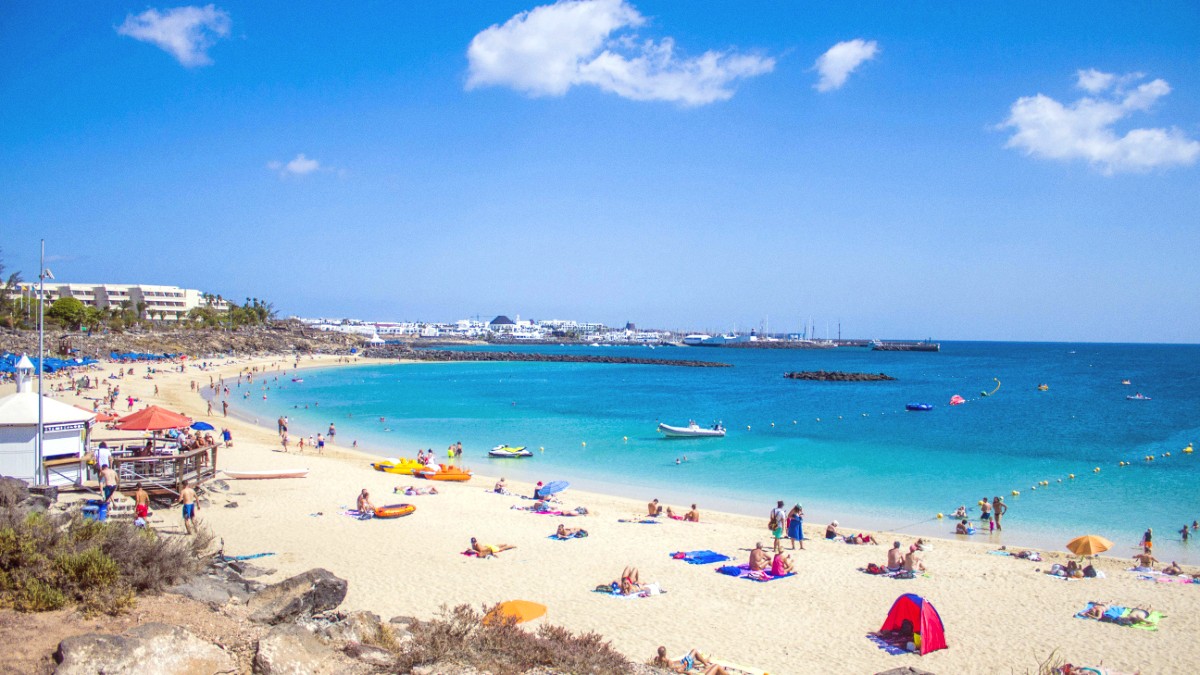
Lanzarote, Canary Islands
The landscape around Playa Blanca showcases Lanzarote's volcanic origins. You find stretches of golden sand beaches contrasting with the dark, natural rock formations. The area's sheltered nature works well for enjoying the ocean.
Playa Blanca ranks as Lanzarote's third-largest tourist resort. Its economy derives almost entirely from visitors. The town includes a broad range of places to stay, dining options, and leisure activities.
Playa Blanca is known for its family-friendly environment, clear ocean waters, and direct access to some of Lanzarote's best beaches. The protected Papagayo Beaches are a frequented spot, reachable from town. Playa Blanca also operates as the main port for ferries traveling to Fuerteventura, making it a base for exploring neighboring islands.
Playa Blanca enjoys a subtropical desert climate with warm temperatures year-round and minimal rain. Daily averages are 18°C (64°F) in winter and 25°C (77°F) in summer. Night temperatures are 5-7°C lower. Rain is minimal, typically between October and March. Summers are dry. Humidity is moderate (70-75%). Trade winds contribute a cooling effect.
The island can experience "calima" events, causing Saharan dust, hazy skies, and higher temperatures. These events are infrequent and typically short.
July-August, Christmas/New Year, Easter. Warmest weather, lively atmosphere. Higher prices, more crowded.
April-June, September-October. Pleasant temperatures, fewer crowds, lower prices. Good for exploring.
November-mid December, mid-January-March (excluding holidays). Mild, comfortable temperatures, fewest crowds, lowest prices.
July to September presents the warmest sea temperatures. Swimming is comfortable from May to October.
October to May includes cooler, more comfortable temperatures for hiking and cycling. Volcanic landscapes may be explored year-round.
Plan your budget to match your travel style. Understand local currency, typical prices, and ways to save money. The local currency is the Euro (€). ATMs are common, offering Euros. Withdrawing cash from ATMs or using credit/debit cards for purchases generally offers better value. Inform your bank of your travel plans.
Daily costs around €40-€70. Stay in basic apartments or guesthouses. Cook most meals yourself. Use local bus transport. Enjoy free beach activities. Visit minimal paid attractions.
Mid-range: €70-€150 daily. Stay in 3-4 star hotels or apartments. Eat out at casual restaurants. Use taxis occasionally. Visit a few paid excursions. Rent a car sometimes. Luxury: €150+ daily. Stay in 5-star resorts or villas. Enjoy fine dining. Use private transfers. Rent a car regularly. Take multiple guided tours. Indulge in spa treatments. Enjoy higher-end shopping.
Tipping is not mandatory but welcomed for satisfactory service. In restaurants, round up the bill or leave 5-10%. For taxis, round up to the nearest Euro. For hotel staff, consider €1-€2 per day for cleaners and €5-€10 for bellhops or concierges for helpful assistance.
Lanzarote is part of Spain, located within the Schengen Area.
No general special permits are required for typical tourist activities. Access to some areas within Timanfaya National Park is limited to guided tours via park buses. This intends to protect the volcanic landscape.
The UV index registers high, even in winter. Apply high-SPF Sunscreen. Wear Sunglasses and a Wide-brimmed hat. Seek shade during peak sun hours (12 PM - 4 PM).
Dehydration might occur. Maintain hydration by consuming ample Bottled water regularly. Tap water is desalinated and generally safe, but may taste distinct. Food hygiene in restaurants and shops maintains high standards.
Playa Blanca is a safe tourist destination. Petty crime, like pickpocketing, might occur in crowded areas. Stay aware of your belongings. Serious crime is not common. No specific neighborhoods in Playa Blanca pose a high risk.
Travel insurance carries strong recommendation for all travelers. Coverage should extend to medical emergencies, emergency evacuation, trip cancellation or interruption, and baggage loss. A policy covering medical repatriation holds particular value.